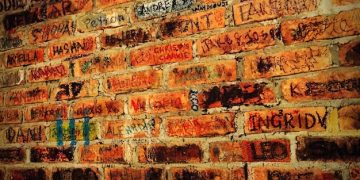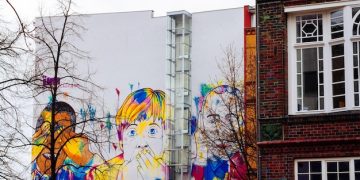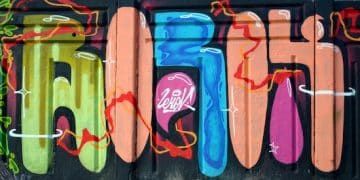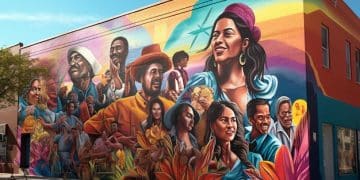US Graffiti Art Regulations 2025: What’s New?
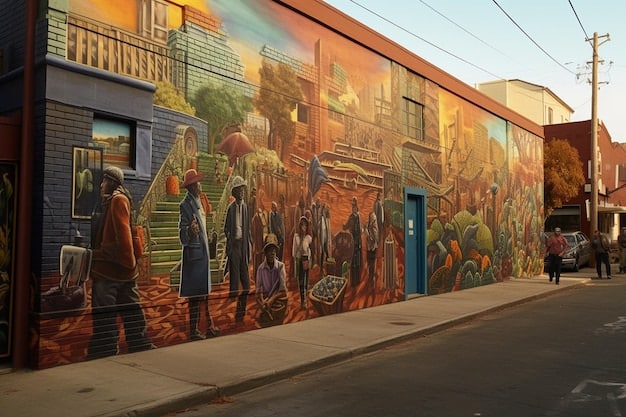
The latest US regulations on graffiti art in public spaces for 2025 reflect a complex interplay of property rights, artistic expression, and public order, with an increasing trend toward localized ordinances that balance cultural preservation with strict enforcement against unauthorized markings.
Understanding what are the latest US regulations on graffiti art in public spaces in 2025 requires navigating a sophisticated landscape where artistic expression confronts municipal order and private property rights. This exploration delves into the nuances of evolving laws, their enforcement, and the implications for both artists and urban environments across the United States.
The evolving legal framework: shifting perspectives on public art
The legal framework surrounding graffiti art in the United States continues to evolve, reflecting a dynamic interplay between artistic freedom, property rights, and public safety concerns. Historically, graffiti has been largely categorized as vandalism, subject to criminal penalties and abatement efforts. However, as public perception shifts and more cities recognize the cultural and economic value of street art, a more nuanced approach is emerging.
In 2025, we observe a growing trend towards localized ordinances rather than sweeping federal mandates. While federal laws might address certain forms of defacement on federal property, the bulk of regulations governing graffiti art in public spaces are enacted and enforced at the state, county, and municipal levels. This decentralized approach leads to significant variations in how graffiti is defined, prosecuted, and managed across different jurisdictions. For instance, a mural that is celebrated as public art in one city might be considered a criminal act in a neighboring town.
Many cities are now grappling with how to differentiate between “vandalism” and “art.” This often involves creating designated areas for legal street art, implementing mural programs, and even commissioning artists. The challenge lies in developing clear guidelines that prevent unauthorized tagging while fostering legitimate artistic expression. This balance is crucial for communities looking to enhance urban aesthetics without compromising public order.
Defining “public space” in 2025 regulations
The definition of “public space” is critical in the context of graffiti regulations. It typically includes publicly owned buildings, parks, transportation infrastructure, and other common areas accessible to the general public. However, the exact scope can vary. Some ordinances extend to private property visible from public thoroughfares, particularly if the graffiti is deemed to impact neighborhood blight or public nuisance.
- Parks and recreational areas: Often subject to strict anti-graffiti measures to maintain cleanliness and safety for visitors.
- Public transportation: Railways, buses, and subways are highly targeted, leading to zero-tolerance policies and swift removal efforts.
- Municipal buildings and infrastructure: City halls, libraries, bridges, and underpasses are primary targets for both sanctioned murals and illegal tagging.
The distinction between public and private space is not always clear-cut, especially with semi-public spaces like commercial plazas or privately owned but publicly accessible art installations. Regulations in these areas often depend on the property owner’s stance and local zoning laws.
Conclusively, the legal landscape in 2025 is characterized by a push for more localized, adaptable regulations that acknowledge the complexities of urban art. This shift requires ongoing dialogue between municipal authorities, artists, property owners, and community groups to forge policies that reflect the unique character and needs of each urban environment.

Enforcement patterns and penalties for unauthorized graffiti
Even as some municipalities embrace street art, the enforcement of laws against unauthorized graffiti remains a significant aspect of urban policy in 2025. Local jurisdictions continue to employ a variety of measures to deter illegal tagging, ranging from aggressive clean-up initiatives to stringent legal penalties for offenders. The approach often depends on the city’s overall philosophy towards public order and blight remediation.
Law enforcement agencies, including local police departments and specialized anti-graffiti units, actively investigate and prosecute individuals who engage in unauthorized markings. These efforts are often bolstered by public awareness campaigns encouraging citizens to report incidents. Surveillance technology, from CCTV cameras to drone monitoring, is increasingly being used in high-graffiti areas to identify perpetrators and gather evidence for prosecution. This focus on identification and apprehension is a key deterrent in many communities.
The penalties for unauthorized graffiti can vary widely depending on the jurisdiction, the extent of the damage, and the prior record of the individual. Most states and municipalities classify graffiti as a misdemeanor, though repeated offenses or extensive damage can elevate it to a felony charge. These charges carry a range of consequences.
Typical penalties and consequences in 2025
- Fines: Monetary penalties are common, often ranging from hundreds to thousands of dollars, depending on the damage cost and local statutes.
- Community service: Offenders may be required to perform community service, often specifically involving graffiti removal or urban beautification projects.
- Restitution: Courts frequently order individuals to pay restitution to property owners for the cost of cleaning or repairing the damage. This can be substantial, especially for large-scale incidents.
- Incarceration: While less common for first-time misdemeanor offenses, jail time can be imposed, particularly for repeat offenders or those involved in significant property destruction. Juvenile offenders may face detention in youth facilities.
- Driver’s license suspension: Some states have provisions allowing for the suspension of a driver’s license for graffiti-related offenses, aiming to impact mobility and deter further acts.
Beyond legal repercussions, individuals caught engaging in unauthorized graffiti may also face social and professional consequences. Their actions can lead to a criminal record, which can impact future employment opportunities, educational pursuits, and even housing options. This long-term impact serves as an additional deterrent for many potential offenders.
Many cities are also investing in proactive measures, such as anti-graffiti coatings on susceptible surfaces and rapid clean-up crews. The rationale behind rapid removal is that immediate abatement deters repeat tagging, signaling that graffiti will not be tolerated and will quickly disappear. This strategy has proven effective in maintaining a cleaner urban environment and reducing the perceived reward for illegal acts. The combination of strict enforcement and swift removal forms the backbone of anti-graffiti efforts in the US in 2025, aiming to balance punitive measures with preventative strategies.
Designated art zones and mural programs: fostering legal expression
Amidst the robust enforcement of anti-graffiti laws, many US cities are simultaneously fostering legitimate artistic expression through designated art zones and public mural programs. This dual approach recognizes that while unauthorized tagging is a problem, street art itself can be a powerful tool for community engagement, urban revitalization, and cultural enrichment. In 2025, these programs are becoming increasingly sophisticated, often involving partnerships between city governments, local businesses, non-profit organizations, and artists.
Designated art zones, sometimes known as “free walls” or “legal walls,” offer artists sanctioned spaces where they can create without fear of prosecution. These areas are typically established in neglected or industrial parts of a city, transforming often-blighted spaces into vibrant outdoor galleries. The success of these zones depends on clear guidelines, regular maintenance, and effective communication with the artistic community. They serve as open canvases, allowing for dynamic artistic evolution and providing a platform for both emerging and established artists to hone their craft and display their work to the public.
Public mural programs are another cornerstone of this positive approach. Unlike free walls, which are open-ended, mural programs typically involve commissioned or curated works. Cities, businesses, or community groups solicit proposals from artists to create large-scale murals on specific walls or buildings. These projects often aim to tell local stories, celebrate cultural heritage, or simply beautify urban landscapes. The funding for such initiatives can come from various sources, including public arts grants, private donations, and corporate sponsorships.
Benefits of fostering legal art spaces
- Urban beautification: Murals and legal walls transform drab or vandalized areas into visually appealing landmarks, enhancing civic pride.
- Economic development: Public art can attract tourism, drawing visitors to specific neighborhoods and boosting local businesses.
- Crime reduction: Studies suggest that investing in public art and reclaiming neglected spaces can deter crime and foster a sense of security.
- Cultural enrichment: These programs provide accessible art experiences for residents and visitors, fostering a vibrant cultural scene.
- Artist support: They offer opportunities for artists to gain recognition, earn income, and contribute positively to their communities.
Local communities play a crucial role in the success of these programs. Workshops, community paint days, and public forums often accompany mural projects, ensuring that the art reflects the values and aspirations of the residents. This participatory approach strengthens community bonds and fosters a sense of ownership over public art initiatives. As these programs mature, cities are increasingly integrating them into broader urban planning and revitalization strategies, viewing public art not as an afterthought but as an essential component of a thriving urban environment.
Technological advancements in graffiti detection and removal
The fight against unauthorized graffiti in 2025 is increasingly benefiting from advanced technological solutions, both in terms of detection and removal. These innovations are designed to make clean-up efforts more efficient, cost-effective, and environmentally friendly, while also aiding in the identification of responsible parties. The integration of technology reflects a continued commitment by municipalities to maintain clean public spaces and address vandalism proactively.
On the detection front, surveillance technology has become more sophisticated. High-resolution CCTV cameras, some equipped with AI-powered analytics, can now be programmed to detect unusual activity in monitored areas, such as individuals loitering near walls or surfaces prone to tagging. These systems can trigger alerts to law enforcement or security personnel, allowing for a more rapid response. Drone technology, offering aerial surveillance, is also being deployed in some larger urban areas to monitor difficult-to-access locations or cover extensive ground, providing a broader perspective on potential graffiti hotspots.
Additionally, community reporting apps have gained traction. These mobile applications allow citizens to quickly photograph and report instances of graffiti directly to city services, often pinpointing the exact location through GPS. This crowd-sourced data empowers rapid response teams and helps authorities track patterns of graffiti, identifying recurring locations or emerging tags. The efficiency of these reporting mechanisms significantly reduces the time between a tag appearing and its removal, adhering to the “rapid abatement” philosophy of deterrence.
Innovative removal techniques
- Laser cleaning: Non-abrasive laser technology is being used for delicate surfaces, effectively removing paint without damaging the underlying material. It’s particularly useful for historical monuments or textured surfaces.
- Eco-friendly solvents: Development of new, biodegradable cleaning agents that are less harsh on the environment and safer for workers, reducing the ecological footprint of removal operations.
- Anti-graffiti coatings: Transparent sacrificial coatings are applied to surfaces; when tagged, the graffiti adheres to this layer, which can then be easily removed along with the graffiti, leaving the original surface intact.
- Pressurized water and blasting: Improved high-pressure washing systems and abrasive blasting techniques are still widely used for resilient surfaces, with innovations focusing on more targeted application and debris containment.
The objective behind these technological advancements is twofold: to make the urban environment less hospitable for illegal graffiti artists by increasing the likelihood of detection and swift removal, and to minimize the long-term costs and environmental impact associated with clean-up operations. While technology provides powerful tools, its effectiveness is often maximized when integrated with strong community engagement and a comprehensive enforcement strategy.
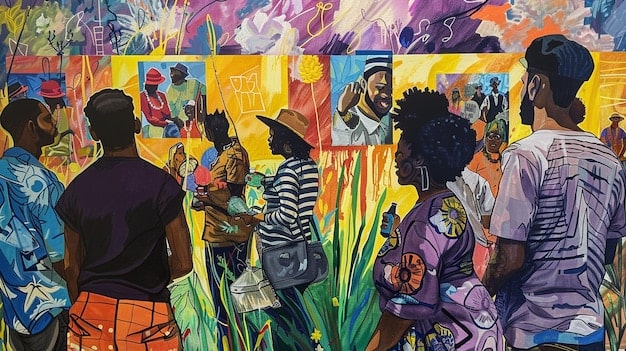
The ongoing debate: freedom of expression vs. property rights
At the heart of the discourse surrounding graffiti art in public spaces lies a fundamental tension between the constitutional right to freedom of expression and the protection of private and public property rights. This debate is deeply complex, without easy answers, and continues to shape legislative efforts and public perception in 2025. It forces society to grapple with what constitutes art, who owns public visual space, and where the line between artistic statement and criminal defacement is drawn.
Advocates for graffiti as a legitimate art form argue that it is a powerful medium for social commentary, political protest, and personal expression. They often liken it to other forms of public art, emphasizing its raw, democratic nature and its ability to transform urban landscapes. For some, unauthorized graffiti is a voice for the marginalized, a means to reclaim public space, or a spontaneous act of creativity that defies institutional control. From this perspective, overly restrictive regulations are seen as stifling artistic innovation and limiting free speech, especially when other forms of public expression are tolerated.
Conversely, property owners – both private and public – assert their right to control their assets and to protect them from damage or unwanted markings. They view unauthorized graffiti as vandalism, a costly nuisance that diminishes property values, creates an impression of disorder, and can even attract further illicit activity. The cost of removal, maintenance, and the perceived decline in neighborhood aesthetics are significant concerns for property owners and municipal governments alike. Their argument centers on the idea that an individual’s right to expression does not supersede another’s property rights or the community’s right to an orderly environment.
Navigating the legal and ethical complexities
- Defining “Art” vs. “Vandalism”: Legally, the distinction often hinges on consent. If the property owner has not given permission, it is typically deemed vandalism, regardless of artistic merit.
- Public vs. Private Property: The debate intensifies on public property, where the notion of shared spaces and collective visual environment comes into play.
- Economic Impact: The financial burden of graffiti removal is a significant factor in shaping regulations and enforcement priorities.
- Community Consensus: Finding a balance often requires extensive public dialogue and community input to determine what forms of art are welcomed and where.
Some cities attempt to bridge this divide through mechanisms like designated legal walls or public art commissions. These initiatives aim to provide avenues for artistic expression while protecting property. However, the fundamental tension between individual expressive freedom and collective property rights remains a constant challenge in urban management, requiring ongoing adaptation and discussion to find common ground that respects both artistic endeavors and community interests.
Community engagement and preventative strategies
In 2025, a growing number of U.S. cities are realizing that a purely punitive approach to graffiti is often insufficient. Instead, they are increasingly investing in community engagement and preventative strategies to reduce unauthorized tagging and foster a more positive urban environment. These approaches recognize that addressing the root causes of graffiti, fostering civic pride, and providing constructive outlets for creativity can be more effective long-term solutions than simply removing tags or prosecuting offenders.
One key aspect of community engagement involves education and outreach programs, particularly aimed at youth. These initiatives seek to inform young people about the legal consequences of unauthorized graffiti and the negative impact it has on their communities. Simultaneously, many programs offer alternative creative outlets, such as workshops on mural painting, graphic design, or street art techniques in sanctioned environments. By channeling artistic energy into legal and positive endeavors, these programs aim to steer potential taggers away from illegal activities.
Neighborhood beautification projects are another powerful preventative strategy. When residents actively participate in maintaining and beautifying their public spaces, a sense of ownership and responsibility emerges. Graffiti is less likely to occur in areas that are well-maintained, clean, and actively used by the community. These projects can include community gardens, public art installations through legal channels, and regular clean-up drives. Such initiatives not only deter graffiti but also enhance the quality of life for residents.
Effective preventative measures in 2025
- Youth art programs: Providing mentorship and resources for young artists to develop their skills in legal settings.
- Community watch initiatives: Encouraging residents to report graffiti promptly and work with local authorities to address it.
- Urban design: Implementing design elements that are less conducive to graffiti, such as textured walls, vegetation, or well-lit areas.
- Public-private partnerships: Collaborating with businesses and property owners to sponsor anti-graffiti programs and art initiatives.
- Rapid removal: Emphasizing swift removal of unauthorized graffiti to signal that it is not tolerated, thereby reducing the perceived reward for tagging.
Furthermore, some cities are exploring restorative justice practices for juvenile offenders. Rather than immediate incarceration, these programs focus on repairing the harm caused by graffiti through community service, counseling, and education, often involving the victims of the vandalism. This approach aims to rehabilitate offenders and integrate them back into the community as productive members, rather than simply punishing them. By combining enforcement with a strong emphasis on community participation and proactive prevention, cities aim to foster a culture where creativity is celebrated and public spaces are respected by all.
Future outlook: potential shifts and considerations for 2026 and beyond
Looking ahead to 2026 and beyond, the landscape of US regulations on graffiti art in public spaces is likely to continue its dynamic evolution. Several factors suggest potential shifts in policy, enforcement, and public perception. Urban environments are constantly changing, and with them, the challenges and opportunities presented by street art. Understanding these potential shifts is crucial for city planners, artists, property owners, and community advocates alike.
One significant consideration is the increasing role of digital art and augmented reality (AR) in public spaces. As technology advances, artists may explore non-physical forms of public art that exist layered over physical reality, accessible through smartphones or AR glasses. This raises new questions about what constitutes “public space,” “vandalism,” and “property” in a digital overlay. Regulations may need to adapt to address these new forms of expression, balancing public access with the prevention of digital defacement or unwanted intrusions.
There’s also a growing recognition of the mental health aspects related to urban environments. Proponents of public art argue that vibrant, artistic spaces contribute positively to psychological well-being, while detractors of unauthorized graffiti highlight its links to perceptions of disorder and decay. Future regulations might increasingly incorporate these psychosocial dimensions, promoting art that fosters community resilience and well-being, while still addressing the negative impacts of unsanctioned markings. This could lead to more robust funding for sanctioned art programs and a greater emphasis on community-led design initiatives.
Key areas of potential change
- Climate change considerations: Regulations might factor in the environmental impact of graffiti removal chemicals and promote sustainable art materials.
- Data-driven policy: Increased use of data analytics to identify graffiti hotspots, analyze underlying social factors, and inform targeted interventions.
- Restorative justice expansion: A continued shift towards restorative justice and rehabilitation over purely punitive measures for first-time or juvenile offenders.
- Artist licensing/registration: Some cities might explore voluntary or mandatory registration programs for street artists as a way to engage them in legal opportunities and foster accountability.
- Integration with tourism: Further development of public art trails and tours that leverage street art as a significant attraction, influencing urban planning and investment.
The role of artificial intelligence in both detection and creation of art will also be a fascinating area to watch. While AI can aid in surveillance, it could also become a tool for creating public art, posing questions about authorship, intellectual property, and public perception. Ultimately, the future of graffiti art regulations will hinge on an ongoing dialogue between legal authorities, urban planners, artists, and the diverse communities they serve. Policies will likely trend towards greater localization, flexibility, and a stronger emphasis on balancing control with the nurturing of urban creativity, ensuring that public spaces remain dynamic and reflective of collective values.
| Key Aspect | Brief Description |
|---|---|
| 🏙️ Localized Ordinances | Regulations vary significantly by city and state, emphasizing local control over federal mandates. |
| ⚖️ Enforcement & Penalties | Misdemeanor to felony charges, fines, community service, and restitution for unauthorized graffiti. |
| 🎨 Art Programs & Zones | Increasing city-sponsored murals and legal walls to foster sanctioned artistic expression. |
| 💡 Tech & Prevention | Advanced detection (AI, drones) and eco-friendly removal, alongside community engagement campaigns. |
Frequently asked questions about graffiti art regulations
▼
While federal laws might address defacement on federal property (e.g., national parks, government buildings), the vast majority of graffiti regulations and their enforcement occur at the state, county, and municipal levels. This decentralized approach leads to considerable variation in laws, definitions, and penalties across different US jurisdictions, making local ordinances the primary concern.
▼
Legally, the distinction largely depends on consent. “Graffiti” typically refers to unauthorized markings on public or private property without the owner’s permission, classifying it as vandalism. “Street art” often implies art created with permission, such as commissioned murals or works on designated legal walls. Artistic merit is not typically a legal differentiator; consent is key.
▼
Yes, engaging in unauthorized graffiti can lead to a criminal record. Most jurisdictions classify it as a misdemeanor, but repeated offenses or significant property damage can elevate the charge to a felony. A criminal record can have long-term impacts on employment, education, and housing opportunities, making it a serious consequence for offenders.
▼
Yes, many US cities offer legal spaces for graffiti artists. These include “free walls” or “legal walls,” which are designated areas where artists can paint without fear of prosecution. Additionally, numerous cities and communities run public mural programs, commissioning artists to create large-scale artworks on approved surfaces, fostering legal and celebrated artistic expression.
▼
Cities are increasingly deploying technology for both graffiti detection and removal. This includes high-resolution CCTV with AI analytics, drone surveillance for difficult-to-reach areas, and mobile apps for public reporting. For removal, innovations feature laser cleaning, specialized eco-friendly solvents, and advanced anti-graffiti coatings, enhancing efficiency and minimizing environmental impact.
Conclusion
In 2025, the evolving landscape of US regulations on graffiti art in public spaces reflects a multifaceted approach, balancing stringent enforcement against unauthorized acts with a growing recognition of street art’s cultural value. While penalties for illegal tagging remain significant, communities are increasingly embracing proactive strategies, fostering legal art zones, and leveraging technology for both detection and beautification. The ongoing dialogue between property rights, artistic expression, and public order continues to shape policies, pointing towards a future where urban environments strategically integrate art into their fabric, recognizing its power to both enhance and challenge, under a framework designed for collective benefit and individual safety.
